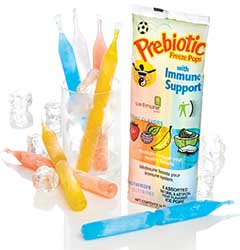Fueling Healthy Kids
NUTRACEUTICALS
It has been years since I have watched any children’s television shows with my own kids, but I recently read that some of the characters in Sesame Street had undergone a mini makeover, acknowledging one of today’s top health concerns: children’s nutrition. Cookie Monster eats his cookies once a week as a special treat, and Bert and Ernie can be found jumping rope and snacking on fruits and vegetables. The new message is that certain things like cookies are something you can eat sometimes, but there are some foods that you can eat all the time, like vegetables.
Lean protein, low-fat dairy, and fruits and vegetables all are part of a balanced diet that contributes recommended nutrients for children. Eating healthier is just one aspect of children’s nutrition that both food companies and parents are focused on. Other areas include bone health, cognition, and immunity. This article will look at some of the nutritional ingredients that target these areas for kids.
Whole Grains
Last year, Cargill, Minneapolis, Minn. (www.cargill.com), released results of a proprietary survey investigating parents’ attitudes and drivers of food and beverage purchases for their children (Cargill, 2013). As part of the company’s childhood nutrition initiative, Cargill found that parents are more likely to seek foods and beverages that appeal to the whole family rather than products and meals that are just for kids. In addition, another key finding of the Cargill Gatekeeper Purchase Drivers Study was that parents tend to seek positive attributes such as whole grains and fiber rather than avoiding the things they perceive to be unhealthy such as fat, sugar, and sodium.
 To illustrate some of its research, Cargill food scientists developed kid-friendly foods and beverages that contain less sodium, sugar, and fat, and more whole grains, fiber, and protein in accordance with specific childhood nutrition standards. These were highlighted at last year’s IFT Food Expo. A whole grain chocolate chip cookie featured Horizon Milling® WheatSelect® white spring whole wheat flour and Oliggo-Fiber® chicory root fiber, offering 10 g of whole grain per serving and a good source of fiber. Oliggo-Fiber® was also featured in a peanut butter spread for kids. Sour tropical punch snack puffs, featured MaizeWise whole grain corn flour and contained 10 g of whole grain per serving. Other prototypes included a reduced-sodium sausage pizza popper made with whole grain and turkey sliders on a whole grain-rich bun.
To illustrate some of its research, Cargill food scientists developed kid-friendly foods and beverages that contain less sodium, sugar, and fat, and more whole grains, fiber, and protein in accordance with specific childhood nutrition standards. These were highlighted at last year’s IFT Food Expo. A whole grain chocolate chip cookie featured Horizon Milling® WheatSelect® white spring whole wheat flour and Oliggo-Fiber® chicory root fiber, offering 10 g of whole grain per serving and a good source of fiber. Oliggo-Fiber® was also featured in a peanut butter spread for kids. Sour tropical punch snack puffs, featured MaizeWise whole grain corn flour and contained 10 g of whole grain per serving. Other prototypes included a reduced-sodium sausage pizza popper made with whole grain and turkey sliders on a whole grain-rich bun.
Immunity
Parents and teachers often refer to classrooms as petri dishes, especially during the winter months when kids come down with colds, flu, and more. Preventing kids from getting sick is one aspect of immunity that is important to parents. Yeast beta-glucan, probiotics, and prebiotics have all been shown to play a role in children’s immune health.
--- PAGE BREAK ---
Wellmune WGP® from Biothera, the Immune Health Company, Eagan, Minn. (www.biothera.com, www.wellmune.com), is a proprietary baker’s yeast beta 1,3/1,6 glucan that is clinically proven to prime key immune cells that keep the body healthy. Most recently, Wellmune WGP was selected as an ingredient for a new children’s lozenge, U!be Strong® (U!be Group Inc., Taiwan). At last year’s SupplySide West show, Biothera sampled several applications for kids, including products from Natural Immune Products Ltd.’s Mune™ family of beverages; children’s Gummy Protection gummies from Daclaf; a combination of Wellmune and a probiotic in Grupo Gloria’s Prodefensis yogurt; and a freezer pop that combines Wellmune with a prebiotic.
 Last year research presented at the Experimental Biology conference showed that a Mead Johnson milk-based children’s product with Wellmune WGP, a prebiotic blend, and docosahexaenoic acid (DHA) helped maintain respiratory health compared to that observed in healthy children consuming powdered cow milk (Biothera, 2013). Statistically significant results from the clinical research were the subject of a poster presentation by Mead Johnson Pediatric Nutrition Institute. Wellmune WGP is an ingredient in Mead Johnson Enfagrow® and Enfakid® Premium children’s nutritional products in numerous countries in Asia and Latin America.
Last year research presented at the Experimental Biology conference showed that a Mead Johnson milk-based children’s product with Wellmune WGP, a prebiotic blend, and docosahexaenoic acid (DHA) helped maintain respiratory health compared to that observed in healthy children consuming powdered cow milk (Biothera, 2013). Statistically significant results from the clinical research were the subject of a poster presentation by Mead Johnson Pediatric Nutrition Institute. Wellmune WGP is an ingredient in Mead Johnson Enfagrow® and Enfakid® Premium children’s nutritional products in numerous countries in Asia and Latin America.
Prebiotics include inulin, oligofructose, and fructooligosaccharides. They have been shown to have a role in immune health by promoting a healthy gastrointestinal microflora environment. NutraFlora® prebiotic fiber from Ingredion Inc., Westchester, Ill. (www.ingredion.com), is derived from pure sugar cane utilizing a bio-fermentation proprietary process and non-GMO ingredients. The short-chain structure of NutraFlora enables it to be preferentially fermented in the gut by Bifidobacteria and Lactobacilli strains while not being available to pathogens.
A recent study has provided further evidence that the use of an oligofructose-enriched inulin, Orafti® Synergy1 from BENEO Inc., Morris Plains, N.J. (www.beneo.com), in infant formula is safe, well-tolerated, and demonstrates a prebiotic effect in infants during the first four months after birth (BENEO, 2013). Neonates receiving a formula supplemented with the prebiotic fiber (0.8 g/dL Orafti® Synergy1) showed a microflora composition close to that of breast-fed infants, with a higher proportion of Bifidobacteria, softer stools, and a higher deposition frequency compared to the control group receiving maltodextrin.
 Probiotics have become more main-stream in recent years. Last year, DuPont Nutrition & Health, New Century, Kan. (www.food.dupont.com, www.dupont.com), unveiled a new HOWARU® Protect premium probiotic range providing clinically documented immune health benefits. HOWARU® Protect Kids (Bifidobacterium lactis Bi-07™ and Lactobacillus acidophilus NCFM®) helps keep children healthy during the cold and flu season. Based on a study published in Pediatrics, results showed that HOWARU® Protect Kids supported respiratory health with symptom duration shortened from 6.5 to 3.5 days, a strong reduction in antibiotic use, and a reduced number of sick days (DuPont Nutrition & Health, 2013).
Probiotics have become more main-stream in recent years. Last year, DuPont Nutrition & Health, New Century, Kan. (www.food.dupont.com, www.dupont.com), unveiled a new HOWARU® Protect premium probiotic range providing clinically documented immune health benefits. HOWARU® Protect Kids (Bifidobacterium lactis Bi-07™ and Lactobacillus acidophilus NCFM®) helps keep children healthy during the cold and flu season. Based on a study published in Pediatrics, results showed that HOWARU® Protect Kids supported respiratory health with symptom duration shortened from 6.5 to 3.5 days, a strong reduction in antibiotic use, and a reduced number of sick days (DuPont Nutrition & Health, 2013).
Chr. Hansen Inc., Milwaukee, Wis. (www.chr-hansen.com), offers probiotics that have been shown to promote immune health in infants through college-age students. Last year, the company introduced probiotic oil drops for infants and young children (www.chr-hansen.com/probioticdrops). The drops contain Chr. Hansen’s bacteria strain Bifidobacterium BB-12® and sunflower oil. BB-1® has a long history of use and has been tested in numerous clinical studies from newborn preterm infants to the elderly.
In college students, Smith et al. (2013) demonstrated that Lactobacillus rhamnosus LGG® and BB-12® from Chr. Hansen may be beneficial for those with upper respiratory infections for shortening the duration of colds and minimizing the severity. Healthy college students living on campus were randomized to receive placebo or probiotic-containing powder (daily dose of minimum 1 billion colony-forming units of each LGG® and BB-12®) for 12 weeks. The median duration of upper respiratory infection was significantly shorter by 2 days, and median severity score was significantly lower.
--- PAGE BREAK ---
A recent study showed that feeding babies with infant formula enriched with Lacprodan® OPN-10 from Arla Foods Ingredients, Basking Ridge, N.J. (www.arlafoodsingredients.com), supported their immune development. Lacprodan® OPN-10 is made from the whey protein osteopontin, a bioactive component associated with the maturation of the infant immune system. Osteopontin is found in high concentrations in human milk—about 138 mg/L—but in much lower concentrations in bovine milk (about 15 mg/L). Researchers from China’s Fundan University Hospital and the University of California at Davis conducted a double-blind randomized clinical trial in which Chinese infants aged between 1 and 6 mo were fed either regular infant formula or infant formula supplemented with Lacprodan® OPN-10, with both groups compared with a reference group of breastfed babies.
The results showed that the babies who were given infant formula supplemented with Lacprodan® OPN-10 experienced a similar number of days of fever to those fed breast milk and a reduced number of days of fever compared with a control group fed ordinary infant formula (Arla Foods Ingredients, 2014).
Bone Health
Calcium and vitamin D are essential nutrients for bone development and health. Other ingredients, such as prebiotics and vitamin K are emerging as promoters of bone health by aiding in calcium and other mineral absorption.
For example, NutraFlora has been shown to increase the absorption of minerals through the production of short-chain fatty acids. In the gastrointestinal tract, minerals must stay in solution in order to be absorbed, and tend to precipitate out of solution at higher pH ranges. The production of short-chain fatty acids lowers luminal pH to an optimal level for keeping minerals in solution longer, thereby enhancing their absorption.
Vitamin K, which has been associated with heart health, has also shown a role in bone health. PLT Health Solutions, Morristown, N.J. (www.plthealth.com), offers a natural vitamin K-2 as menaquinone-7. Information from the company explains that bones grow and develop most intensively during childhood and adolescence. Binding minerals to healthy bone matrix maximizes bone mineral density in order to maintain bone mass later in life. Once peak bone mass is met in the mid to late 20s, loss will continue as we age.
Vitamin K is essential for the body to utilize calcium. Proteins involved in building a healthy bone matrix and keeping calcium from accumulating in the artery walls need vitamin K to work properly. Recent research shows that vitamin K-2 is the form of vitamin K that the body uses for bone and cardiovascular health. Natural vitamin K-2 as menaquinone-7 is safe and effective within current RDIs, recommended at just 45 mcg daily.
Cognition
The importance of omega-3 fatty acids, particularly DHA, for brain development in infants is well known among parents. It can be found in infant formulas as well as toddler snacks. Research continues to point to the role DHA plays in kids’ academic careers.
For example, Willatts et al. (2013) demonstrated that variation in the dietary supply of long-chain polyunsaturated fatty acids (LC-PUFAs) such as DHA and arachidonic acid (ARA) in the first months of life may have long-term consequences for the development of some cognitive functions in later childhood. Infants were randomly assigned to receive formula containing either DHA and ARA or no LC-PUFAs for a period of 4 mo. A reference breastfed group was also included. In a follow-up study conducted at the age of 6 years, children received assessments of intelligence quotient, attention control, and speed of processing. IQ scores of children who were fed a formula containing either LC-PUFAs or no LC-PUFAs did not differ at age 6. However, children who received LC-PUFAs were faster at processing information compared with children who received unsupplemented formula.
Richardson et al. (2012) indicated that DHA supplementation appeared to offer a safe and effective way to improve reading and behavior in healthy but underperforming children from mainstream schools. Healthy children aged 7–9 years initially underperforming in reading were given either 600 mg/day DHA (from algal oil), or taste/color matched corn/soybean oil placebo to determine the effects of dietary supplementation with DHA on the reading, working memory, and behavior of healthy schoolchildren. A significant effect in standardized reading scores was observed in a group of children whose initial reading performance was below the 20th percentile. Parent-rated behavior problems (ADHD-type symptoms) were significantly reduced by active treatment, but little or no effects were seen for either teacher-rated behavior or working memory.
 Linda Milo Ohr,
Linda Milo Ohr,
Contributing Editor, Denver, Colo.
[email protected]
References
Arla Foods Ingredients. 2014. New clinical trial backs Arla Foods Ingredients’ infant immunity ingredient. Press release, Feb. 4.
BENEO. 2013. Scientific study confirms the safety and prebiotic effect of BENEO’s Orafti® Synergy1 in infants. Press release, May.
Biothera. 2013. Research on child respiratory health presented at Experimental Biology. Press release, June 19.
Cargill. 2013. Cargill news and prototypes will feature themes of childhood nutrition and sustainability. Press release, June 26.
Cargill. 2013. Cargill research reveals parents’ purchase drivers of foods and beverages for their kids. Press release, July 15.
Chr. Hansen. 2013. A drop a day keeps the doctor away. Press release, Jan. 5.
DuPont Nutrition & Health. 2013. DuPont launches HOWARU® Protect probiotics to maintain natural immune defenses. Press release, Nov. 12.
Richardson, A.J., Burton, J.R., Sewell, R.P., Spreckelsen, T.F., and Montgomery, P. 2012. Docosahexaenoic acid for reading, cognition and behavior in children aged 7–9 Years: a randomized, controlled trial (The DOLAB Study). PLoS One 7(9): e43909. Published online Sept. 6. doi: 10.1371/journal.pone.0043909
Smith, T.J., Rigassio-Radler, D., Denmark, R., Haley, T., Touger-Decker, R. 2013. Effect of Lactobacillus rhamnosus LGG® and Bifidobacterium animalis ssp. Lactis BB-12® on health-related quality of life in college students affected by upper respiratory infections. Br. J. Nutr. 109(11): 1999-2007.
Willatts, P., Forsyth, S., Agostoni, C., Casaer, P., Riva, E., and Boehm, G. 2013. Effects of long-chain PUFA supplementation in infant formula on cognitive function in later childhood. Am. J. Clin. Nutr. Aug. 98(2): 536S-42S.


